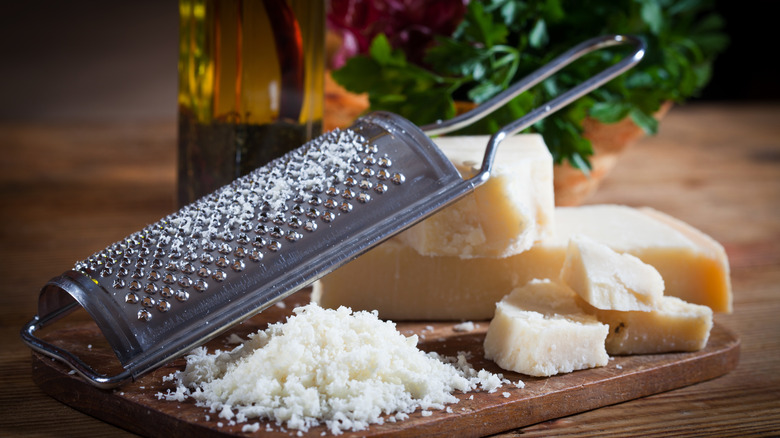What Are The Differences Between Parmesan And Romano Cheese?
When putting the finishing touches on a towering bowl of fresh fettuccine or a heaping slice of classic lasagna, there's only one ingredient you need: good Italian cheese. From gooey mozzarella to sharp asiago, there is no shortage of delicious dairy products at your disposal. But when it comes to topping a dish, you'll likely be focused on two common options — Parmesan and romano. You're probably familiar with both of these Italian staples, which can be grated, shredded, or sliced. Many Italian dishes call for one, or both, of these cheeses, and you might even spot them blended together in a single package on the shelves of your local grocery store.
While parmesan and romano look similar when grated — and are sometimes even interchangeable — they are two distinct cheeses with unique flavors and textures. The main difference is driven by their dairy source. Parmesan is made from cow's milk while romano is made from sheep's milk, which drives the distinct tastes in each product. Parmesan is also aged much longer than romano, which gives it an extra crumbly texture.
All about Parmesan cheese
Parmesan cheese is crafted from cow's milk combined with bacteria cultures and an enzyme called rennet, which causes the mixture to congeal. After curds are formed, cheesemakers heat this early-stage product and pour it into a mold. Once the cheese is molded into a wheel, it is soaked in a salty solution and then left to age. Parmesan is aged for at least 12 months, although some varieties are aged for multiple years. The final product is a white cheese with a golden-yellow rind.
Generic Parmesan cheese should not be confused with certified Parmigiano Reggiano, a Parmesan variety that is produced in a specific region of Italy. The Italian government strictly monitors the production practices and product quality of a Parmesan before awarding it the Parmigiano Reggiano label. The cheese is often left to mature for three years or more.
Whether it's authentic Parmigiano Reggiano or an American substitute, Parmesan cheese packs a punch of substantial flavor. Salty, rich, and slightly nutty, Parmesan is an excellent savory addition to a dish, and can also be eaten on its own. Because the age of Parmesan will often dictate what it tastes like, the different levels of aging create strikingly different cheeses; typically, older cheeses will become more crumbly and hold a more intense flavor.
Romano: made from sheep's milk
The process for making romano is quite similar to Parmesan, with one major caveat: romano is usually made with sheep's milk. Like Parmesan, the raw milk is cultured, turned into curds, and then pressed into molds. The cheese is then aged for at least six months. This process results in a hard, white cheese that has a distinctive black rind.
Like Parmesan, romano cheese also has an official Italian variety: Pecorino Romano, which is only produced in Sardinia in central Italy. Pecorino Romano is always made with sheep's milk; confusingly, American-made romano can also be made with cow's milk. Because sheep's milk contains different fatty acids than cow's milk, Pecorino Romano has a much sharper and stronger taste than Parmesan. Generic versions of romano using cow's milk might have a milder taste that is more in line with Parmesan.
In the kitchen, romano is known for its distinctive sharp taste that has a hint of spiciness. Like Parmesan, it's a hard cheese ideal for grating and crumbling. It's often used as a shredded pasta topper to add a bold taste to a dish and won't be obscured or hidden by a rich tomato sauce. If you're using romano as a substitute for Parmesan, you may want to find a milder variety made with cow's milk, otherwise, expect a stronger taste if you're using the sheep's milk Pecorino Romano.


